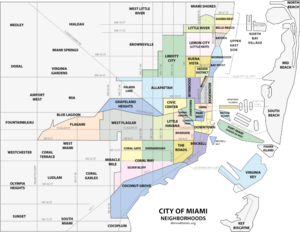Venetian Islands, Florida
| Venetian Islands | |
|---|---|
| Neighborhood of Miami | |

View of the Venetian Causeway and Venetian Islands with South Beach in the background, as seen from the Omni neighborhood
|
|
 Venetian Islands neighborhood within the City of Miami |
|
| Coordinates: 25°47′26.99″N 80°9′39.51″W / 25.7908306°N 80.1609750°W | |
| Country | United States |
| State | Florida |
| County | Miami-Dade County |
| City | Miami |
| Islands of the Venetians Islands |
Islands list
|
| Government | |
| • City of Miami Commissioner | Marc Sarnoff |
| • Miami-Dade Commissioners | Audrey Edmonson |
| • House of Representatives | Cynthia A. Stafford (D) |
| • State Senate | Gwen Margolis (D) |
| • U.S. House | Ileana Ros-Lehtinen (R) and Debbie Wasserman Schultz (D) |
| Time zone | EST (UTC-05) |
| ZIP Code | 33139 |
| Area code(s) | 305, 786 |
The Venetian Islands are a chain of artificial islands in Biscayne Bay in the cities of Miami and Miami Beach, Florida. The islands are, from west to east: Biscayne Island (Miami), San Marco Island (Miami), San Marino Island (Miami Beach), Di Lido Island (Miami Beach), Rivo Alto Island (Miami Beach), and Belle Isle (Miami Beach). Flagler Monument Island remains an uninhabited picnic island, originally built in 1920 as a memorial to railroad pioneer Henry Flagler. The islands are connected by bridges from the Miami mainland to Miami Beach.
The Venetian Islands project was proposed to be much larger than what exists today. Another causeway was to be built, called "The Drive of the Campanili." The causeway would connect Hibiscus Island (south of the Venetian Islands) with Di Lido Island. The road would then continue north right up the center of Biscayne Bay, with five new islands created along its path. The roadway would then veer slightly to the northeast, where it would end at Indian Creek Village. An additional four islands would be built along two east-west roads that would connect with the causeway. One of these roads was along the current route of the Julia Tuttle Causeway and the other along the current route of the 79th Street Causeway.
The original bridge (called the Collins Bridge) was built by farmer and developer John S. Collins with financial assistance from automotive parts and racing pioneer Carl G. Fisher. At the time it was completed, it was the longest wooden bridge in the world. The 2½ mile wooden toll bridge opened on June 12, 1913, providing a critical link to the newly established city of Miami Beach, formerly accessible only by a ferry service.
...
Wikipedia
